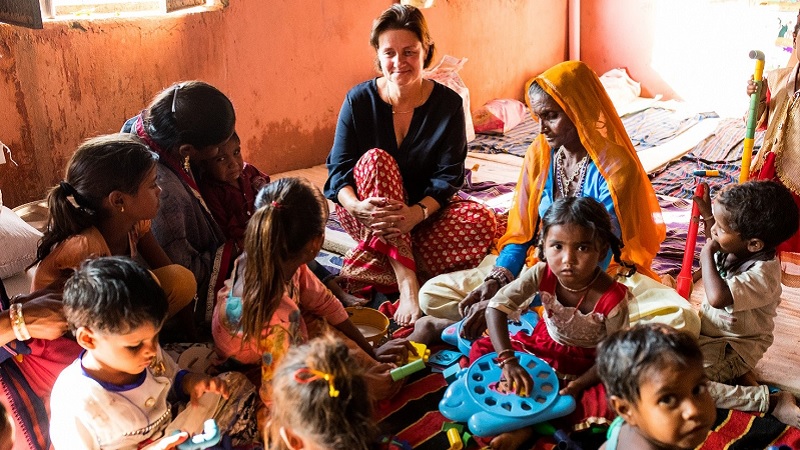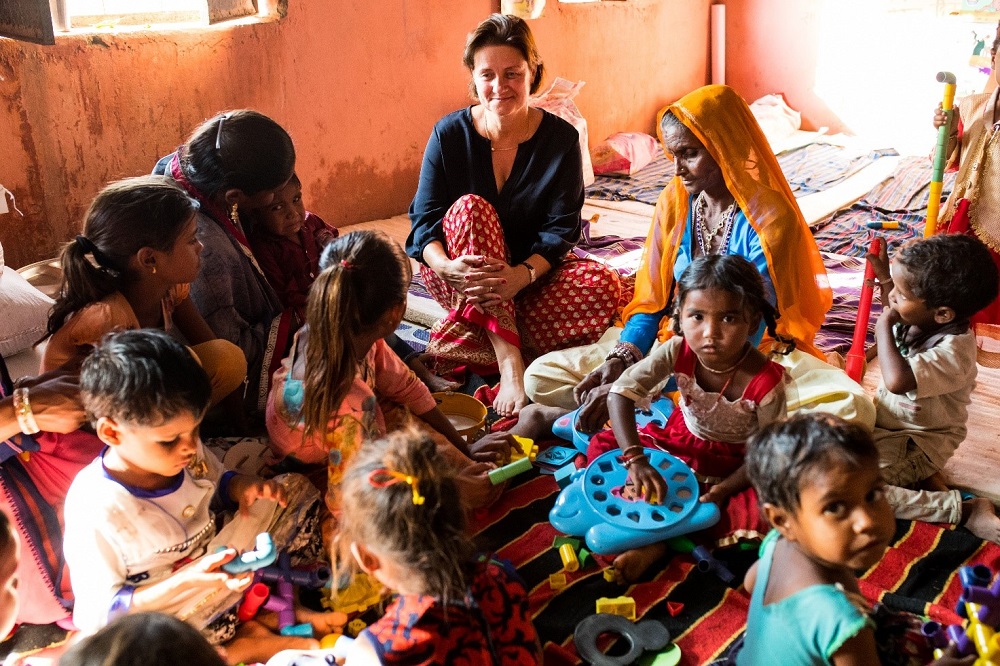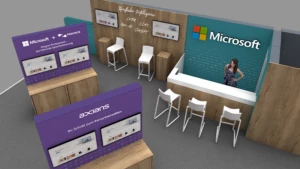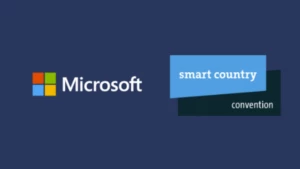
When artificial intelligence comes alive
Travel impressions from the Indian state of Madhya Pradesh
In October 2018, a six-member team from Welthungerhilfe, Microsoft Germany and the digital agency PAGES Media travelled to Sawadi and Heerapur, two villages in the Indian state of Madhya Pradesh, to see the technology initiative for the Child Growth Monitor, CGM for short, live in action. They wanted to gain a better understanding of the problems and challenges encountered in the practical application in order to set the course for future improvements based on these insights. The following travelogue reflects my personal impressions.
You can help children suffering from malnutrition by donating to Welthungerhilfe.

On our way to regions where help is urgently needed
Endless fields pass before my eyes, the air is shimmering with heat. The train, which takes us 350 kilometres south from the airport in Delhi towards Gwalior—and thus closer to the current Child Growth Monitor innovation project of Welthungerhilfe—clatters through barren landscapes and small towns. The first impressions of a megacity with 11 million residents are still fresh in my mind: heavy, roaring traffic, questionable infrastructure (by our Western standards) and countless people living in poverty on the littered streets. The nationwide, comprehensive poverty and the simplest of living conditions are quite depressing to witness. Actually being here on site helps us understand what it means when, statistically speaking, 600 million people in India have no access to a working sewage system.

We will visit two small villages in the state of Madhya Pradesh, where Welthungerhilfe is currently pushing ahead with its most important innovation project: the development of an app to detect malnutrition in children between the ages of 0 and 5 in order to provide the right kind of help to those affected in good time. The app runs on modern smartphones with infrared sensors that are used to measure the children. An algorithm uses artificial intelligence to evaluate the countless data points in order to determine whether a child needs help. Based on the generated data, the affected children will be assigned to special nutrition programmes in order to counteract an imminent delay in development.
Jochen Moninger, Head of the Innovation Unit at Welthungerhilfe, initiated the project. Since the beginning of this year, Microsoft has been on board as technology partner, while Munich Re supports the cooperation with comprehensive expertise in the evaluation of large amounts of data. Social Impact Partners, the link between Munich Re’s operational business units and the humanitarian organisations in the development aid sector, is also involved. This journey is our chance to follow the real application and get an impression of the challenges in order to coordinate the next reasonable steps. We are accompanied by a camera team from PAGES Media who will shoot a project video.
Stopover in the middle of nowhere between Sawadi and Heerapur: hunger is invisible.
Sheopur district, in the North of Madhya Pradesh state, is the second stop of our journey. Madhya Pradesh has almost 73 million inhabitants and is one of the poorest and least developed states in India. The national Human Development Index ranks it at number 27 out of 29.
In the kindergarten in the village of Sawadi, which is home to 164 families, experts from Welthungerhilfe are working together with trained residents to assess the nutritional status of the children. Here we saw the smartphone app in action for the first time: The infrared sensors capture thousands of data points of a child in different body positions in 3D images. This creates a huge amount of data whichttps://www.microsoft.com/de-de/industry/blog/wp-admin/post-new.phph can only be reasonably processed using computing power from the cloud. The underlying AI algorithm continues to learn, which ensures that the accuracy is constantly improved.

I came to realize one important thing which at the same time underlines the significance of the project: Deficiency or malnutrition is not visible to the naked eye, and yet it affects 40 percent of children in Sawadi alone. It is a fact that while some children look “normally” nourished at first sight, they have an unfavourable weight-to-height ratio that can adversely affect their cognitive development. External signs such as small stature or apathy are merely indications, but they are not substantial measurement parameters. On the other hand, some children are quite active and cheerful, but still need nutritional help.
The core problem in the fight against hunger, namely the identification of those in need of help, cannot be solved effectively using traditional methods (weighing and measuring). On the one hand, only 70 percent of children are measured and weighed at all, and on the other hand, the manual processes and technically fragile devices result in high error rates, which means that up to 50 percent of the data cannot be used. At the same time, the processes are too lengthy and lack transparency: The lists of data often reach the charities only two years later and it is also not possible to monitor the progress of individual children. Objective measurement criteria and easy-to-use tools are needed, and this is exactly where the Child Growth Monitor of Welthungerhilfe comes in, as Jochen Moninger convincingly explains in this interview.
And this completes the circle. The Child Growth Monitor not only ensures better, more cost-effective and faster data capture, but also enables a more precise evaluation and continuous tracking, so that help can be targeted and reach the right children.
On our way home to Germany with a suitcase full of memories
These few days in India have left a deep impression on all of us. As Microsoft employees, Kassandra Xavier Esteves and I have had the chance to get involved not only on a theoretical level, but to have this lasting, hands-on experience to make a project ready for the market. The Child Growth Monitor is an example of how companies—in this case Microsoft, Munich Re and Social Impact Partners—can get directly involved in social business projects, optimally combine their respective expertise and make a real difference in this world.

The past few days have shown us that NGOs cannot tackle large innovation projects such as the Child Growth Monitor alone, but need strong partners to support them. Although NGOs can make a difference with donations, long-term commitment from private sector companies that bring their own core competencies and know-how to the table has an even broader effect.
We are already looking forward to the next steps. Our plan is to make the advantages of the Child Growth Monitor with its new way of data collection also available to other development aid organisations. In fact, the app is set to become the new standard worldwide. Therefore, the next goal of Welthungerhilfe is to establish the Child Growth Monitor as a social business next year and to recoup the costs through entrepreneurial action by generating revenue. A commitment to social business in turn offers participating companies the advantage of increasing their company value in the medium and long term.
From Microsoft’s point of view this means: technology and innovations from cloud computing and artificial intelligence are used here as a lever to initiate a fundamental change that will benefit people in developing countries in the long term and in a sustainable manner. The Child Growth Monitor is a vivid example of how Microsoft’s mission—Empower every person and every organization on the planet to achieve more—becomes reality.

Conclusion
On this journey, one thing became clear to all project participants: Seeing a project come to life with your own eyes is completely different from discussing the deployment of computing resources in the cloud or AI technology at a desk or in a meeting room.
With the Child Growth Monitor, we were able to see on site how the processes work, where there is potential for improvement and what problems arise when measuring and collecting data. Practical questions, practical solutions.
At this point our special thanks goes to the following people:
- Welthungerhilfe, especially Jochen Moninger and Pooja Chowdhary, who were not only an important link in the contact with the villagers, but also highly effectively steered the project thanks to their many years of experience and economic thinking.
- The data analysts at Munich Re and Dr Michael Menhart, who have willingly made their know-how available and never tired of emphasising the social dimension of this project.
- The dedicated team from PAGES Media, for whom the CGM project was a matter close to their heart and who were not held back by problems with visas and filming permits in the run-up to the event, and who were also able to optimally arrange the cooperation with the Indian camera team on site.
- The Microsoft leadership team with Joao Couto and Martin Große, who put their heart and soul into this project and made this trip possible for us, as well as all other Microsoft colleagues involved.
You can help children suffering from malnutrition by donating to Welthungerhilfe.




